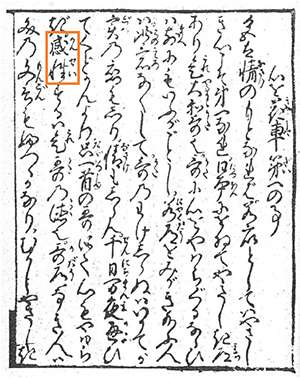The Past, Present, and Future of Kansei
The Origin of Kansei

Extract from Yoshida manuscripts (1687/1950).. The word “KANSEI” is highlighted within the orange square.
The term Kansei re-appeared later in the translation of Kant’s Critique of the pure reason, done by Teiyu Amano in 1930. Amano translated the word “Sinnlichkeit” into Kansei. Sinnlichkeit is described by Kant as the faculty of intuitions, perception, and mental imagery, sense-related, object-dependent, immediate, or directly referential, and non-conceptual (Hanna, 2009).
Fast forwarding to modern times, in 1984 the term Kansei made another reappearance with the publication of two books made by the Dentsu company. These books discuss the shift that was occurring in consumers’ behavior in Japan. From an expected and “logical” behavior to a more unpredictable Kansei-like behavior, and because of this shift in behavior, the companies had to change from “mass production planned for everybody”, to an adaptive mass-production responsive to each consumers’ tastes and wishes. This discussion started a movement that made Kansei step outside the academic world into the industrial one.
Kansei’s First Application in the Japanese Industrialized Era
The first and probably the most important application in the industrial world, was made by Mitsuo Nagamachi, a professor at Hiroshima University. He created the term of Kansei Engineering which was used for the first time in 1986 by Mazda Automotive Corporation, for an early appraisal project which ended up with the creation of the Mazda Miata “MX-5”. Kansei Engineering can be described as a systemic approach based on a reductionist method to translate user’s feelings (hedonic variables) into concrete product parameters. However, the objectification of the data and their explicit definition which an engineering approach is required, seems to contradict the subjective and pre-predicative qualities of Kansei. Therefore, Kansei Engineering does not aim directly at correlating user’s Kansei with design details, but to establish a correlation between users’ expressed impressions and design details.

2020’s Mazda MX-5 Source: CarScoops 2022
The Science of Kansei
At the same time, Kansei studies as a form of science were being developed at the University of Tsukuba. As a scientific discipline, Kansei Science focuses on exploring people’s Kansei with cognitive science. In other words, cognitive neuroscience, and psychophysiology. Kansei Science also relies on related philosophies such as the mind/brain identity theory (Smart, 2011) to understand human thinking and resulting behaviors which can be best understood by using a model involving metal representational structures and the mental procedures that operate these structures (Thagard, 2011). In this context, Kansei Science has aimed to characterize and to evaluate emotional experiences and creativity, to contribute to a better understanding of the mind based on knowledge derived from physiological and psychological approaches. Moreover, the outcomes of Kansei Science research have very often worked with design research to conjointly develop new methods for design and communication (Lévy et al., 2011).
Present and Future of Kansei
In recent years, the evolution of Kansei has introduced Kansei Design as a new discipline for Kansei research. Although speaking about design is often related to tangible artifacts, characteristics may be defined using the Kansei Engineering approach. Kansei Design projects can be categorized into two groups based on the main focus. The first group focuses on the physical materiality of an artifact, and the evaluation or preference of the user. This group of projects uses Nagamachi’s proposals for reducing people’s hedonic variables and applying analytics to define design parameters attempting to avoid ambiguity and uncertainty by means of design skills according to the psychophysiology of the final user. The second group focuses on the interactive materiality or the experience of the artifacts, by using the relationship between the craftsmen and their artifacts. Kansei Design incorporates all the varieties of points of view held by artifact’s designer and the users.
Scholars in Kansei and Design estimate that the future of kansei will be based on the interactions and experiences between user and artifact, since it is foreseen that instant access to information will become more usual. This situation will create new challenges for product designers and companies that have to personalize products for each individual in order to maintain their competitive advantage in this globalized world.
Are you interested in knowing how you could use Kansei in your business, send us your inquiry here.
Sources:
Hanna, R. (2009). Kant’s theory of judgment.
Smart, J. J. C. (2011). The mind/brain identity theory.
Thagard, P. (2011). Cognitive science.
Lévy, P., Yamanaka, T., Tomico, O. (2011). Psychophysiological applications in kansei design.
Lévy, P. (2013). Beyond Kansei Engineering: The Emancipation of Kansei Design.
